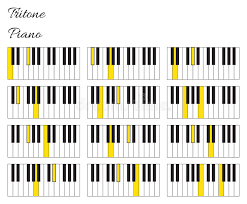How to use tritones in music Lesson 2
Last time we looked at tritones and how to voice and use them in a progression, especially as passing and approach chords. We considered using major triads over a tritone pair. We mentioned that we could use other triads too. Let's see those other triads and how they come into play.
Minor Triads
A dominant 9 chord in root position has the last three notes as a minor triad. F9 for example is FACEbG, with the last three notes as CEbG which is Cmin. We can put this minor triad on our RH over a LH AEb tritone pair viz: CEbG/EbA and let the bass play the root note for us.
A closer look shows this tritone voicing to be ACEbG which is Amin7b5. So, min7b5 chords are easy targets for a tritone voicing that uses a minor triad on the RH. We see this type of chord as the 7th degree diatonic chord of a major scale. This also features as a secondary leading tone chord to various degrees on the major scale. For e.g. Emin7b5 leading to an Fmaj7. Here, E is the 7th degree diatonic chord of the Fmaj scale but used in a progression in key Cmaj, it becomes a secondary leading tone chord to the 4th degree. So we can voice it as Gmin over an E tritone i.e. GBbD/BbE. We can do what we did on the F9 chord by playing the GBbD/BbE over a C bass note [making it a C9 chord instead] or we can just play the E too as the bass.
Another way to use a minor triad in the tritone voicing is to extend the major triads we had in the first post to major 7th chords and playing this rootlessly. One of the chords we saw last time was BbDF/CGb. If we extend the RH Bbmaj triad to a major 7th, it becomes Bbmaj7 i.e. BbDFA. We then play this Bbmaj7 rootlessly as DFA. This turns our tritone voicing into DFA/CGb which is D7#9 [DF#ACE#]. The first one [BbDF/CGb] was D7#5#9 [DF#A#CE#]. We can see that by playing a specific minor triad on our RH, we changed the chord by just dropping the altered 5th [#5]. It still remains a D altered dominant chord and both are fully functional as one [unless the #5 has a harmonic function it played].
We could also play the entire major 7th chord on our RH. So we could play FABbD/GbC which is D7#9b13 [DF#ACE#Bb]. You might wonder why I mix accidentals in my chord notes. That because that's how it would be written on the staff, showing the exact notes and not their enharmonic equivalents. You might also wonder why a b13 and not a #5. Well that's because the rule of naming chords forbids a note to exist as a natural and an altered note simultaneously. That means I couldn't have a 5 as A and a #5 as A#. The #5 has to be a b13 instead.
A b13 is a common color note added to dominant chords.
Try CEFA/C#G ~ CEFA/DA
That's A7#9b13 to Dmin9. The RH remains the same. Just roll it up [arpeggriate] on the first chord and roll it down on the second chord to give it a different feel.
Just remember that voicings is the choice of the player as per what harmony creation is intended.Augmented Triads
An augmented chord is one that has the 5th degree augmented i.e. raised by a semitone. This, right away, gives us an augmented triad to use in voicing an augmented dominant chord.
C7#5, also called C augmented 7th, is CEG#Bb, and can be voiced as CEG#/EBb or G#CE/BbE. Augmented triads are purely symmetrical so any inversion of the augmented triad fits.
A 9b5 chord too, gives us an augmented triad to use.
Ab9b5 is AbCEbbGbBb i.e. AbCDGbBb. The last 3 notes form an augmented triad i.e. DGbBb which is Daug [DF#A#]. Therefore, Ab7b9 can be voiced as DGbBb/GbC over an Ab bass of course. Any inversion of this Daug fits.
A closer look at the voicing DGbDb/GbC shows it is D7#5 [DF#A#C]. Over an Ab bass note, it becomes Ab9b5. We know that a D chord would lead to a G, Db or Eb chord. Well, so also does an Ab chord. The reason is simply because they are a tritone away, so their dominant chords will behave the same way.
Check this: C7 is CEGBb. Play it over Gb as C7/Gb i.e. CEGBb/Gb and you got yourself a Gb7b5b9 chord. This is a simple trick, to play one dominant chord and play the bass as a note a tritone away from the root of the RH dominant chord.
Let's try another: E7#5#9/Bb voiced as EGC/G#D/Bb which is Bb13#11, gotten from the Bb Lydian Dominant Scale [also called the Bb Overtone Scale].
Next would be diminished triads and suspended triads. Till then.

-ChordProgressionGuy
#pianolessons #chords #scales #piano #chordprogression #inversions #tutorial #music #tritones #jazz #lesson #movement